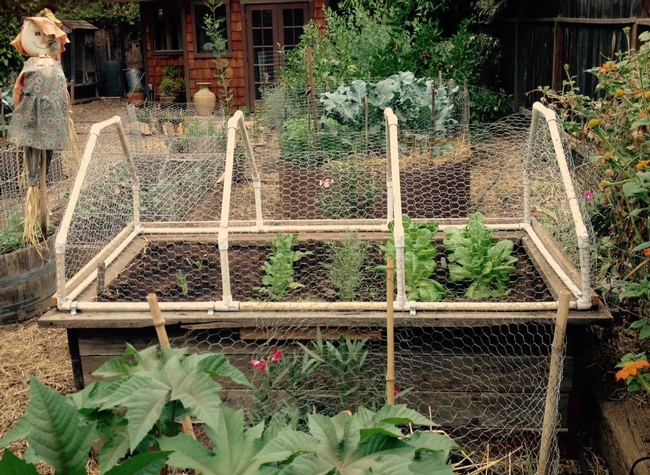By John Smith, Butte County Master Gardener, October 30, 2015

If gophers are a nuisance in your yard, 1/2-inch by1/2-inch hard wire mesh can be nailed to the bottom of a raised bed to prevent gophers from getting to plant roots while allowing water to drain through.
Frustration with gophers is the most common reason gardeners turn to raised beds, but there are many other advantages to this method of gardening. Raised beds allow you to garden no matter what your local soil may be: clay, sand, bedrock, or even contaminated soil. You get to choose the soil your plants will grow in. A mixture of 50% local soil and 50% compost often works well.
If working on your hands and knees is a problem, a raised bed can be built to a height that is comfortable for you. For example, an 18-inch high bed with a 6-inch perimeter board to sit on may be just the right height to facilitate the leisurely tending of one's crops.
The soil in raised beds tends to warm up earlier in the year than does the ground soil, allowing for a longer growing season. Raised beds can easily be customized to accommodate different crops in different seasons. For example, ¾-inch chicken wire, framed with PVC pipe and hinged to one side of the raised bed will prevent squirrels from entering and wreaking their havoc. Attaching clear plastic to the frame during the months of November through March creates a mini-greenhouse for raising salad greens throughout the winter. On sunny days in early spring, opening the enclosure about 6 inches will prevent overheating.
It's amazing how much food a three-foot by eight-foot raised bed can produce. Raised beds also tend to have fewer weeds and are easier to manage.
There are a few disadvantages to raised beds. The biggest drawback may be the expense of building the beds and filling them with soil. Keep in mind that they also lose moisture more quickly than does ground soil.
There are many options for raised bed designs and materials. Raised beds that are three to five-feet wide allow easy reach to the center for tending crops. If your access is only from one side, beds should be no wider than three feet. Redwood and cedar are the most common materials used, but there are many other possibilities. Galvanized steel or rubber containers used for watering cattle or horses can be used, so long as you put many holes in the bottom to allow for good water drainage. These containers are usually two feet deep. They should be available at your local feed store. Sometimes large culvert material can be found at metal junkyards. Particularly useful are those that are a least four feet in diameter. Even old, used, rusted galvanized metal roofing can be enclosed in a wood frame used for raised beds. These can be aesthetically pleasing and add a creative touch to the garden. Cement blocks can also be used to create raised beds.
Don't let gophers, squirrels, moles, poor soil, bedrock, or not wanting to work on your hands and knees deter you from the gratification of growing your own food or flowers! Consider a raised bed for your garden.
For more information visit The California Garden Web.